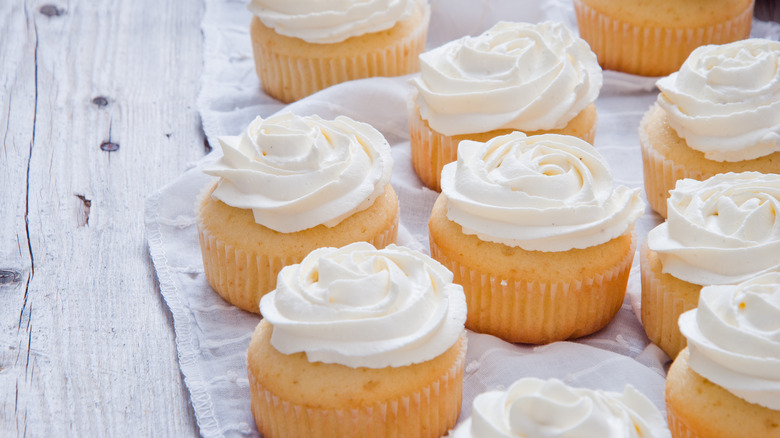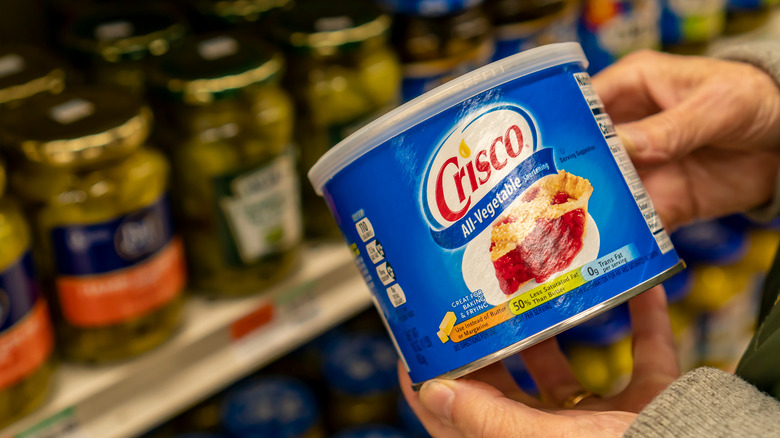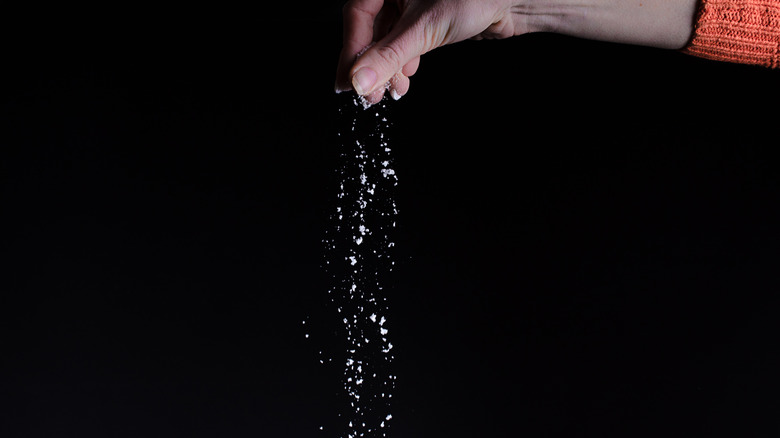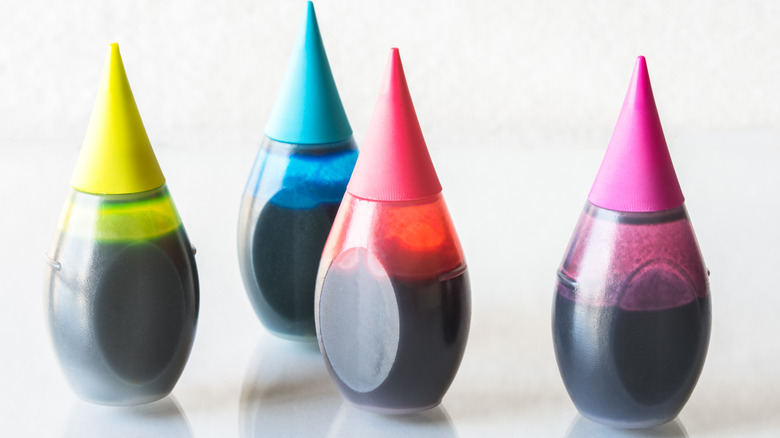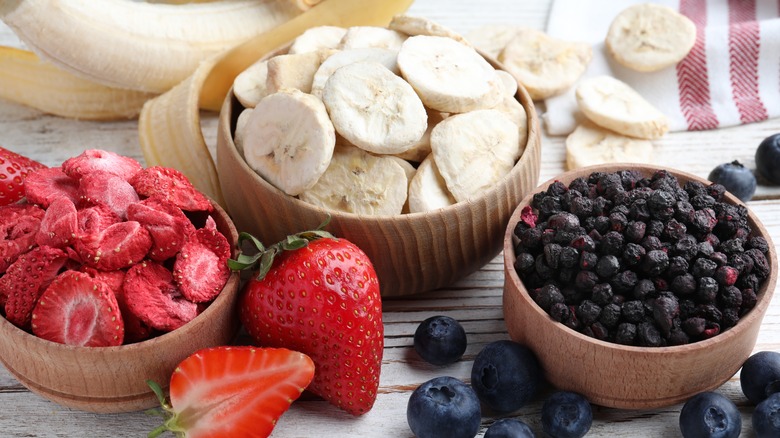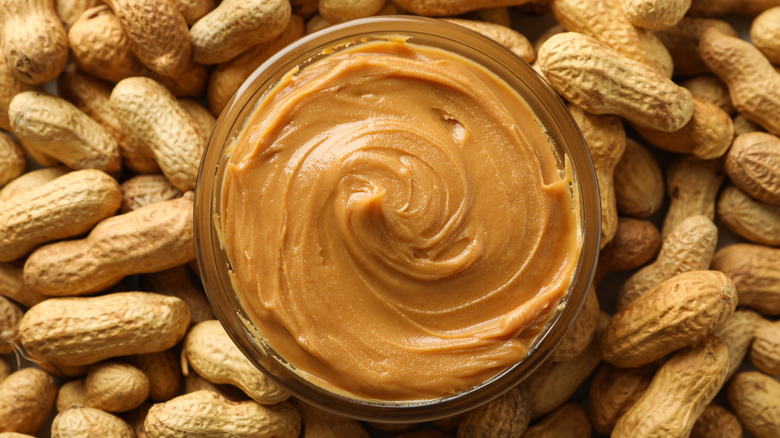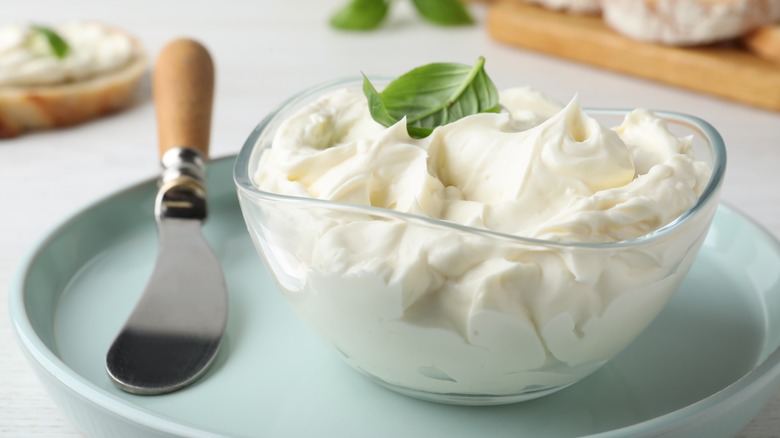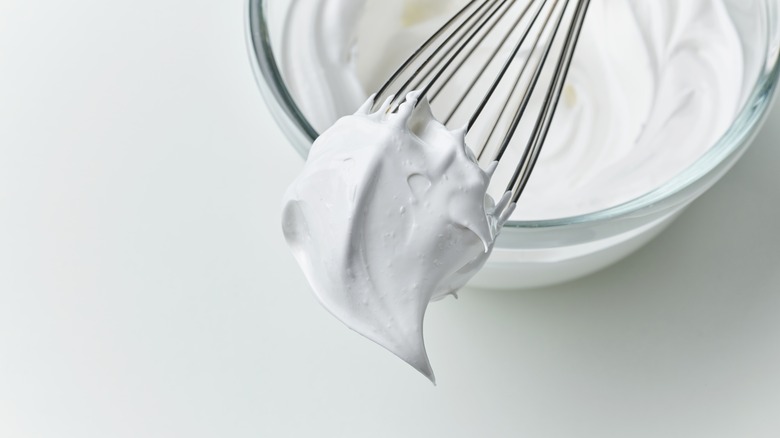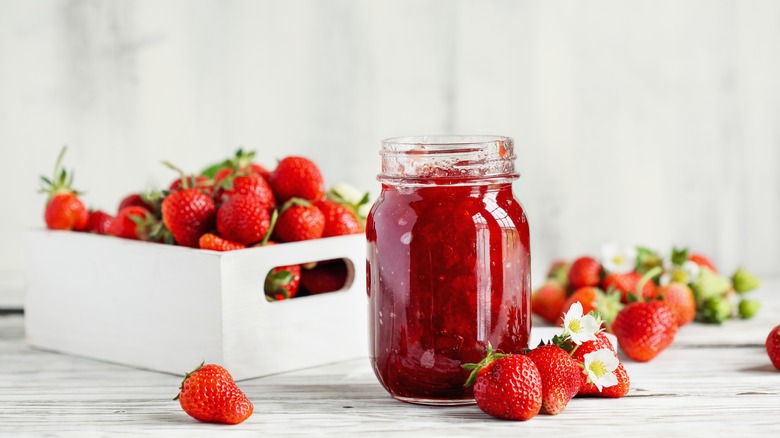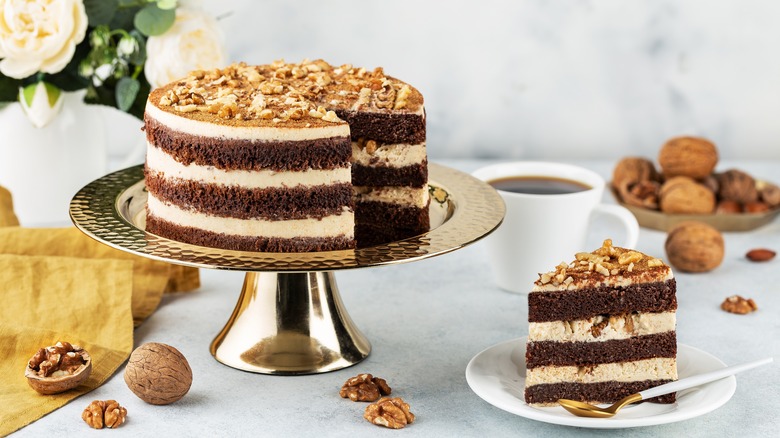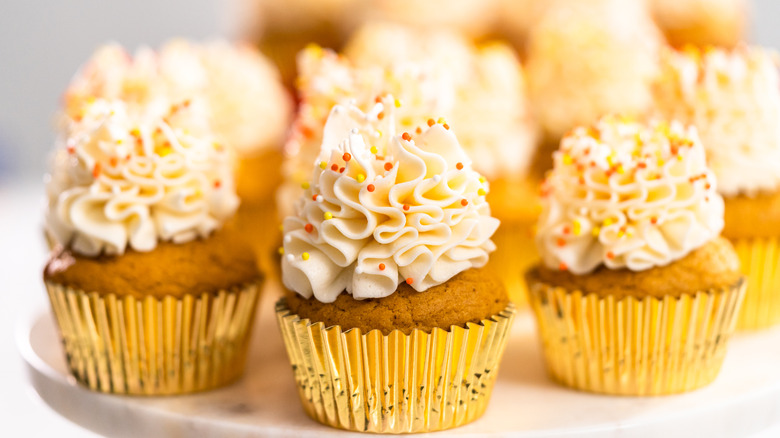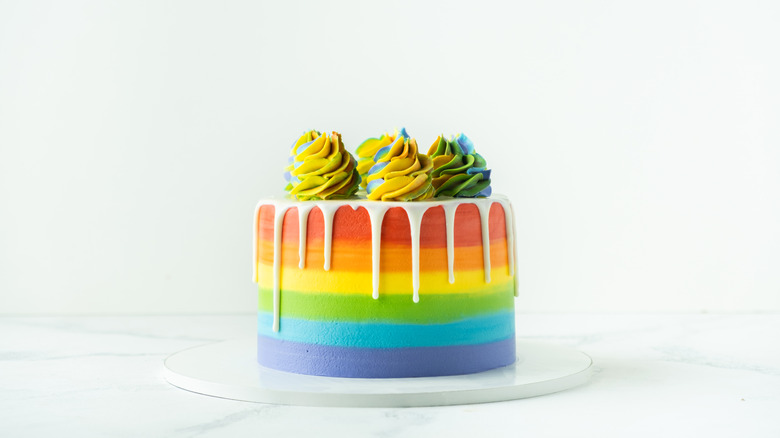11 Ways To Easily Upgrade Buttercream Frosting
If you're looking for an easy frosting to use just about anywhere — birthday cakes, cookies, holiday cakes, and cupcakes — you could do worse than buttercream. One of the easiest frostings to make, and also one of the most versatile frostings around, traditional American buttercream frosting can be thrown together in under 15 minutes using just butter, powdered sugar, vanilla, and milk.
Of course, Americans don't have a monopoly on buttercream. As the cake-decorating experts at Wilton point out, there are actually seven different types of buttercream frosting, including more complicated and complex recipes from Switzerland, France, Germany, and Italy. Some require you to add a meringue to your buttercream, while others boil the frosting for an upgraded texture and taste.
However you prefer your buttercream, though, chances are if you've been making this cake staple for a while, you may want to upgrade your frosting game. After all, while buttercream is close to perfect, it can get a little boring after a bit. Mix up your next batch of buttercream with one of these easy upgrades.
Use shortening in place of butter
A classic traditional American buttercream frosting recipe calls for butter and butter only, but you don't have to only use butter in your buttercream. Other fats work just as well and in reality, some fats are actually better butter substitutes (which is great news for vegan bakers).
Instead of making buttercream with butter, consider either using a mixture of butter and shortening or using shortening on its own. What will the shortening do to your frosting? Well, shortening is more stable than butter, which means it won't melt at room temperature (or even in most hot temperatures). You could leave a tub of Crisco out in the sun for hours and nothing would happen (although, from a food safety perspective, don't try that), whereas a stick of butter would be soft in minutes. This stability is a godsend if you're worried about your frosting getting a little droopy at your summer birthday party. If you use a Crisco-based frosting recipe, you can rest easy knowing your cake will remain pristine and look its best, regardless of the temperature or weather.
Add salt
The basic buttercream ingredients are butter, sugar, vanilla, and milk. However, if you want to upgrade your flavors, consider adding a pinch of salt to your next batch of frosting. Think about it — you're using so much sugar when you make buttercream frosting. The sugar essentially takes up half your buttercream's mass, so it can get really sweet, really fast. To help balance those flavors and ensure your buttercream isn't cloyingly sweet, add a pinch of salt. This simple frosting hack will give you a perfect balance of flavor.
On a more scientific level, salt is an important addition to your sweet treats, frosting included. According to research reported by Science, the presence of salt may actually enhance your body's ability to taste sugar. A study tested reactions in mice, feeding them a combination of sugar and salt, and found that, when examining taste cell nerves exposed to either just sugar or a combination of sugar and salt, the mice exposed to the combination exhibited nerves that fired more rapidly than those of the control group.
Use gel food coloring instead of liquid
Let's say you want to make a buttercream frosting that's not your standard off-white, so you reach into your pantry and pull out your food coloring. If you have the option on-hand, don't go for the liquid food coloring you might use to dye Easter eggs. Instead, opt for gel-based food coloring.
Why? Liquid-based food dyes are just that: liquid. Depending on how much food coloring you need to use, this extra liquid could wreak havoc on your frosting recipe. The gel-based food coloring, as Wilton points out, won't change your frosting's texture. Additionally, you don't typically need to use as much gel food coloring as the liquid type to achieve the same desired results and colors.
The brand also cautions that if you're coloring your frosting a red hue, make sure you buy food coloring specifically labeled as "no taste." Otherwise, the dye can change your frosting's flavor. Likewise, if you're trying to achieve a particularly dark color, rather than add copious amounts of food coloring to your icing, which can also change the flavor, start with a chocolate buttercream base. With your frosting already on the darker side, you can make smaller adjustments to the color from there.
Add freeze-dried fruit powder
While no one adds food coloring to their frosting in an effort to change the flavor, there's one thing you can add to your frosting to provide it with a bold hue as well as a bold flavor: freeze-dried fruit powder. As King Arthur Baking explains, freeze-dried fruit powder is a favorite alternative to artificial dyes and flavorings, and you can easily buy freeze-dried fruit powder made from a range of fruits for a variety of flavors and colors. Go blue or purple with freeze-dried blueberries, or bold red with freeze-dried strawberries or raspberries.
If you can't find freeze-dried fruit powder at the store, you can buy freeze-dried fruit and grind the fruit at home using a food processor or other grinder. King Arthur Baking recommends using 2-3 tablespoons of powder for every cup of buttercream you make. The brand also notes that some fruits give you a more saturated color than others. While most berries offer a big kick of both flavor and color, light-pulped fruits that lose much of their color during freeze-drying — like apples and peaches — will help boost flavor, but won't add much in the way of hue.
Add peanut butter
Peanut butter goes well in a range of desserts, so it should be a no-brainer to add peanut butter to your buttercream frosting if you plan on frosting, say, a chocolate and banana-flavored Caribbean cake. However, you need to be careful when adding peanut butter to any baked good or frosting, as it can impact the end result. While you might think you'd love a frosting filled with lots of extra peanut butter due to the added peanut buttery taste, you might not like how it changes the texture.
To make peanut butter buttercream, you'll want to use equal parts butter and peanut butter because peanut butter is a fat, too — it's not just there for flavor. If you find after making your peanut butter buttercream the mixture isn't quite the texture you want, add more butter or more confectionary sugar, until you get the desired consistency.
Add cream cheese
Who doesn't love a gorgeous cream cheese frosting? It's the perfect complementary topping for a red velvet cake or carrot cake, and cream cheese frosting is even easier to make than buttercream. All you have to do is mix cream cheese with milk, vanilla, and sugar until you get the consistency and flavor you want. But what if you could combine everything you love about cream cheese frosting with everything you love about buttercream?
To add cream cheese to your buttercream frosting, simply make buttercream frosting like normal, but use equal parts cream cheese and butter. This is important because cream cheese is a fat, too, so you don't want to use extra cream cheese on top of the normal amount of butter. The equal-parts distribution allows for the butter-specific texture of buttercream frosting but adds the tangy taste of cream cheese.
If you don't have cream cheese on hand, but would love some cream cheese-infused buttercream for your next bake, there's a hack for that. As Wilton notes, ermine, or boiled, frosting requires no cream cheese but is frequently compared to cream cheese frosting. This more complex take on a normal buttercream boils sugar, milk, and flour before beating them together with butter.
Add whipped cream
If you've ever thought you'd like your buttercream to be a bit on the lighter side (which makes sense, as it can be pretty dense and heavy), then this hack for adding whipped cream to your frosting is for you. But don't think you can just open up a tub of Cool Whip, dump the contents into your buttercream, mix it all together, and call it a day.
This hack — which does give your buttercream a lighter, airier quality — doesn't use store-bought whipped cream. Rather, you need to go the old-fashioned route by making your buttercream like normal before adding heavy whipping cream, bit by bit, until you reach the fluffier, lighter consistency you want. Since this is a lighter frosting, you might not want to use it for decorating jobs that require more stability, but if you're just frosting your standard celebration cake, it'll be a nice surprise.
Add jam, jelly, or fruit puree
Just like you can add freeze-dried fruit powder to your buttercream frosting to give it a burst of flavor and an eye-catching color, you can do the same with jams, jellies, and fruit purees. Unlike the freeze-dried fruit powder, though, the jam, jelly, or fruit puree will also impact the frosting's texture, which is sometimes desirable.
If you're making buttercream with a fruit puree (like, for example, a tempting angel food cake with raspberry buttercream), you'll want to cream your butter and sugar together like normal, then slowly add in the fruit. If this changes the texture dramatically and the frosting begins to separate, do as Wilton advises and pop the separated mixture into the fridge for a few minutes until it cools down, then re-whip it. Don't let the buttercream stay in the fridge for too long, though, as that can result in curdling when you re-whip. Around 10 minutes in the fridge is long enough.
Add something for extra texture
Why relegate your cake toppings to the top of the cake? Mix in some delicious extras and add-ins to give your buttercream extra texture and flavor throughout. There are all sorts of options to pick from.
For instance, mix in sprinkles for a homemade, grown-up version of everyone's childhood favorite, Funfetti. Mix in morsels or chips that match your cake flavor (so, chocolate chips for chocolate cakes or peanut butter morsels for a peanut butter cake), while opting for a different flavor for the overall buttercream to create a nice contrast. You could also experiment with adding shredded coconut, finely chopped nuts, or crushed toffee.
Whatever you add to your buttercream for texture and flavor, be sure to go slow and not add too much at once. Also, keep in mind that if you're adding larger mix-ins, you won't be able to pipe your buttercream as easily, so this method is really only best for standard sheet or layer cakes when you're not planning anything fancy.
Add some unusual flavors
Fruit notes, peanut butter, chocolate chips, toffee — they're all flavors you're already familiar with. Why not level up your next bake with a buttercream that boasts some seriously unusual and surprising flavors?
You could add Grand Marnier liqueur if you're topping a cake that would be enhanced by the spirit's orange notes. Or if you want the orange zest, but not the liqueur? You can achieve a similar effect by literally adding orange zest, along with a little orange juice, to your buttercream. Another breakfast favorite that you could dump into your buttercream? Some coffee (but not too much — remember that adding liquids will affect the texture).
If you'd like to go way off the beaten path, you might try making a matcha cake with black sesame buttercream. This recipe uses your standard butter, powdered sugar, and vanilla, but adds in extra almond extract, salt, and 6 tablespoons of finely ground and toasted black sesame seeds. Not only do the sesame seeds give the buttercream an unexpected flavor, but the ground seeds lend it a slightly gray, chic hue.
Make rainbow frosting with one bowl
Maybe you've seen the rainbow frosting trend on your favorite social media feed, but if not, the gist is that accomplished bakers cover a tall layer cake with a rainbow of buttercream in a mix of seven different colors. If you've wanted to try this — or just wanted to use lots of different colors of frosting at once, rainbow or otherwise — you may have realized something quickly: Making multiple colors of buttercream requires a lot of bowls and a lot of patience.
Luckily, if you want to upgrade your buttercream with multiple hues, there's a coloring hack for that. Rather than splitting your buttercream into multiple bowls, keep it all in one mixing bowl. As you're frosting your cake, make and use your colors one at a time, using only a small portion of the bowl of frosting, rather than mixing the food coloring into the entire batch. Apply each color as needed before going on to make the next color.
For this hack to work, though, and not end in a conglomeration of mixed colors that's more or less just a gross brown shade, you have to follow a specific order: yellow, orange, red, green, blue, and purple. If you follow this list, each color will absorb its predecessor, keeping everything looking lovely.
